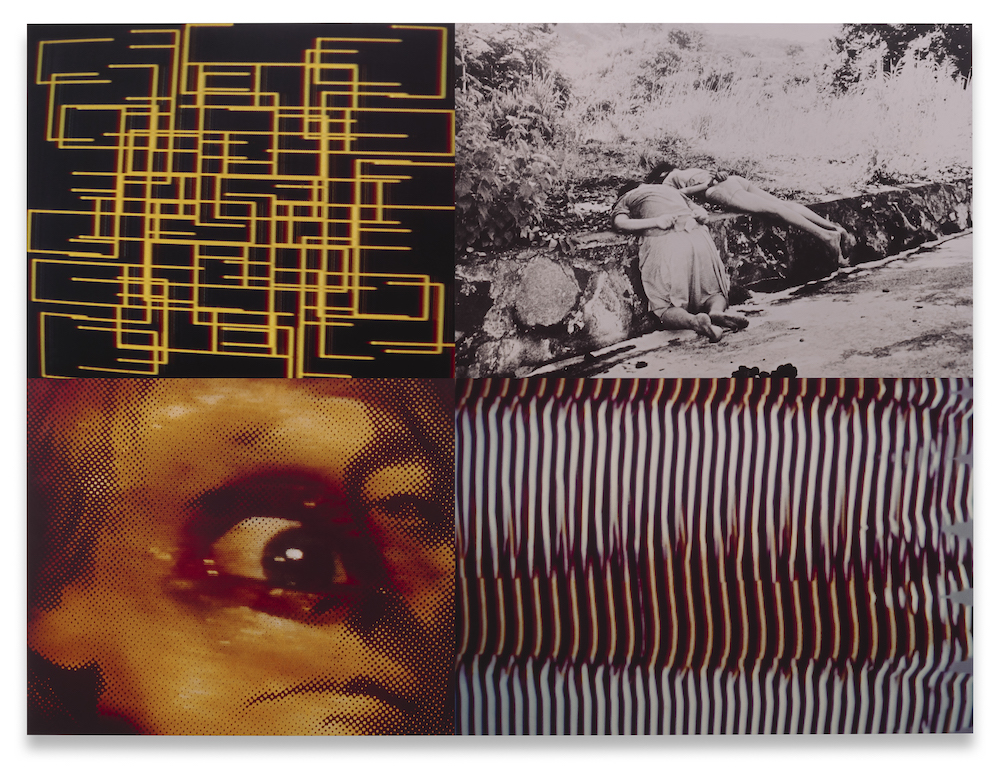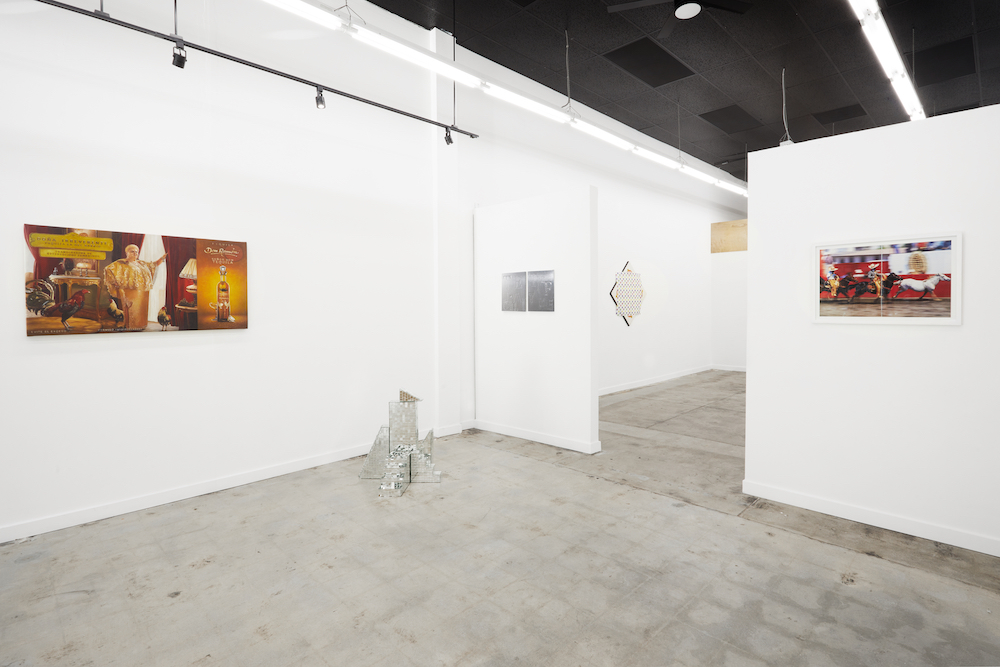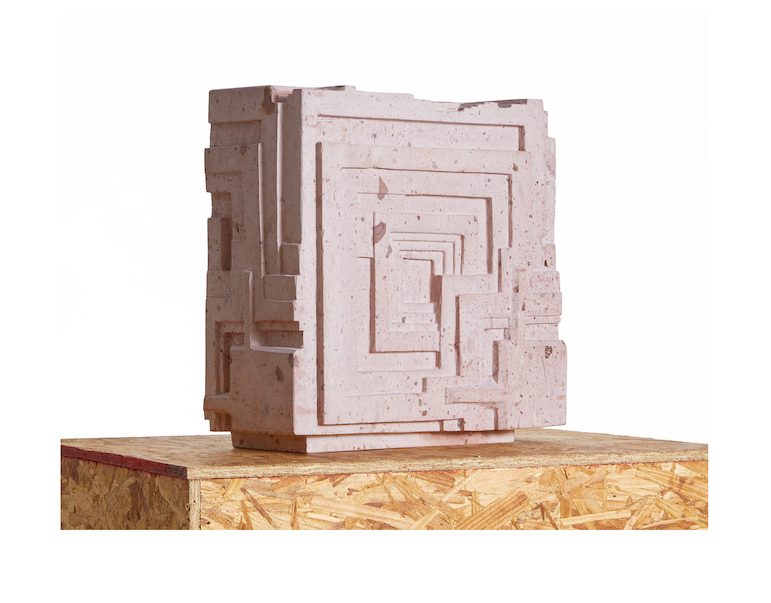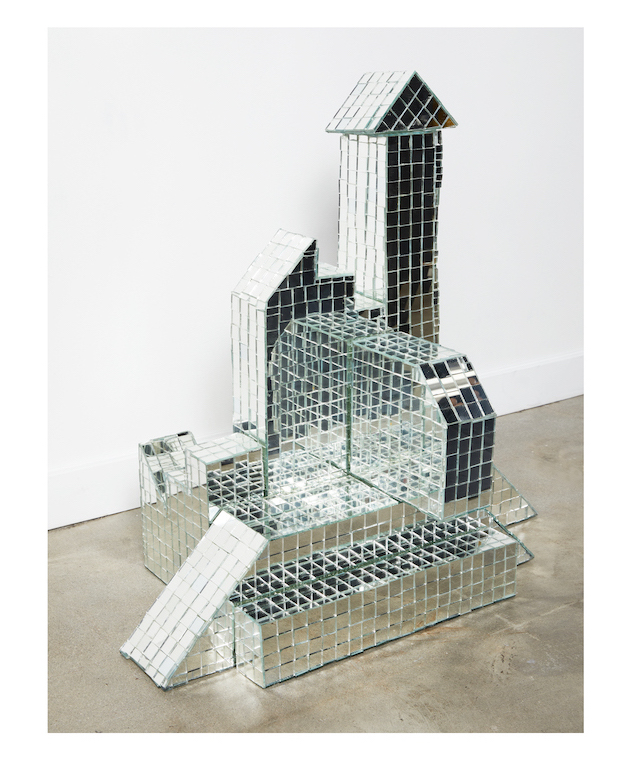Your cart is currently empty!
Byline: Nahui Garcia
-

GALLERY ROUNDS: Gretchen Bender
Sprüth MagersIn 1987, Cindy Sherman interviewed Gretchen Bender for BOMB Magazine, discussing the influence of her work on mass media. Bender denied the relationship between the two and instead described media as a ‘cannibalistic river without a conscience,’ invoking the image of a current that swallows, digests, and regurgitates life into a seamless stream of information. At Sprüth Magers, the solo exhibition “The Perversion of the Visual” digs into Bender’s preoccupation with the United States military intervention in the Salvadoran Civil War, referring to the violently graphic imagery documented by American photographers of the armed conflict.
Titled after the Hollywood film, the four-dye sublimation print Gremlins (1984) places side-by-side images within a single frame: two stills of computer-generated graphics, an eyeball superimposed on a woman’s face, and a black-and-white photograph by the American photojournalist John Hoagland. The photograph portrays two girls lying lifelessly amid overgrown weeds near the highway to Comalapa Airport in El Salvador. Hoagland died by the strike of a bullet during a crossfire between the Salvadoran army and leftist guerrillas the same year Bender created Gremlins. His remembrance, along with that of the unidentified victims, lives through the inclusion of his snapshot like a wormhole that merges past with present. Four decades after the war, Gremlins provokes the same visceral jolt that images of war-torn landscapes once elicited in Bender.
Another work on view is Dumping Core, an eight-channel video installation whose title refers to an early term for a computer crash and the recording of its memory for later analysis. The installation projects what can be described as a screen capture of 1980s television culture. Footage of machine guns and flying helicopters are interwoven with corporate logos (AT&T, CBS, and NBC) and digital animations—all set to a thundering soundtrack of electronic music composed in collaboration with Stuart Argabright, Michael Diekmann, and Shin Shimokawa. Hypnotic and rhythmic, the installation’s sensory overload limits the ability to think beyond the immediate visuals, reflecting the numbing effect of media that Bender critically examined and sought to manipulate.
Bender drew inspiration from the book El Salvador: Work of Thirty Photographers, a compilation of war photographs by Susan Meiselas. The book is on display in a separate room from the installation, along with a collection of print materials illustrating Bender’s involvement in the nationwide activist project “Artist’s Call Against US Intervention in Central America.” For example, an orange poster designed by Claes Oldenburg lists the 1,087 names of participating artists, including Andy Warhol and Sol LeWitt. Other materials include Bender’s manifesto titled The Perversion of the Visual, the 1983 Winter issue of Upfront: A Publication of Political Art Documentation / Distribution, and a xeroxed flyer by Artist’s Call soliciting public participation.
Though Bender is primarily recognized for her mastery of video technology, “The Perversion of the Visual” reveals the depth of her engagement in political commentary. Her tribute to photojournalists portrays death as an interruption to the continuity of life and a disruption to the mechanical routine of American society—to clock out work, return home, and sit on the sofa to watch that day’s evening show. The casualties of the Salvadoran Civil War diverted the stream that Bender once described to Sherman, suggesting that perhaps dying had some significance after all for this uprising and others to come.
-

GALLERY ROUNDS: Marek Wolfryd and Michele Lorusso
John Doe GalleryFor their joint exhibition at John Doe Gallery, Marek Wolfryd and Michele Lorusso present a selection of sculptures and paintings embedded in their shared exploration into Mexico’s history of architecture, urban planning and design. The title, “A Collapsing Reflection,” aptly conveys the essence of their extensive research in the past years; both artists trace the lifecycle of public buildings from inception and construction to eventual decline.
The exhibition featured new works by Wolfryd, including the cube-shaped sculpture 10th Century Retrofuturism (all works 2024). Its layered relief mirrors the textured design on the façade of Frank Lloyd Wright’s 1924 Ennis House, for which the architect employed a precast block system by mixing sand, gravel, and granite extracted directly from Los Feliz, near Griffith Park. Wolfryd, on the other hand, sourced a block of pink-colored volcanic rock native to Central Mexico and typically associated with Mayan architecture. Its mottled surface, with its linear markings etched by the artist’s tools, preserves the lost details that have eroded from ancient pre-Columbian structures built without modern machinery, but human hands.

Marek Wolfryd, 10th Century Retrofuturism, 2024. Courtesy of John Doe Gallery. Wright’s contribution to the Mayan Revival architectural movement conjures an idyllic depiction of Mexico, perhaps more vibrantly tantalizing when compared to the country’s post-industrial towns. Documentation of the residence blurs the line between the inspired-infused decor and the original copy, complicating the task of tracing authenticity to its source. In Notes on National Anthropology, Wolfryd embarks on a similar line of research by drawing parallels between the façade of Mexico City’s National Institute of Anthropology and Victor Vasarelly’s painting series, OND. Both display a closely similar dotted pattern, suggesting a shared visual language that remains unknown, and at least unnoticed by the institution.

Michele Lorusso, Mira Blocks #2, 2024. Courtesy of John Doe Gallery. Next to the painting, Lorusso’s sculptures titled, Mira Blocks #1 and Mira Blocks #2 offer insight into Mexico’s ongoing seismic activity and its impact on architectural design, which have resulted in an environment where buildings fall and rise. The sculptures comprise geometric Styrofoam blocks of varying dimensions, each decorated with mirror squares encrusted onto their surface. The artist stacks them together to craft architectural structures that depend on gravity’s weight for stability. Their foundation, fragile and precarious, mimics the inherent risks created by unethical construction practices aimed at maximizing profits. These practices range from disregarding building regulations to presenting false documentation and using substandard materials, all of which have historically led to mass fatalities in Mexico.
Throughout the show’s run, Lorusso will activate the sculptures by altering the arrangement of the blocks. The day that I visited the gallery, I observed him deconstruct Mira #2 and reassemble it into an entirely new sculpture, complete with a triangular ceiling and vestibule in the front, as I had imagined it. The illusion of control over a structure destined for collapse paradoxically eased, in that moment, my tendency to think catastrophically about future events, including the potential fall of the blocks. I found comfort in knowing that something new can be built from the rubble.



